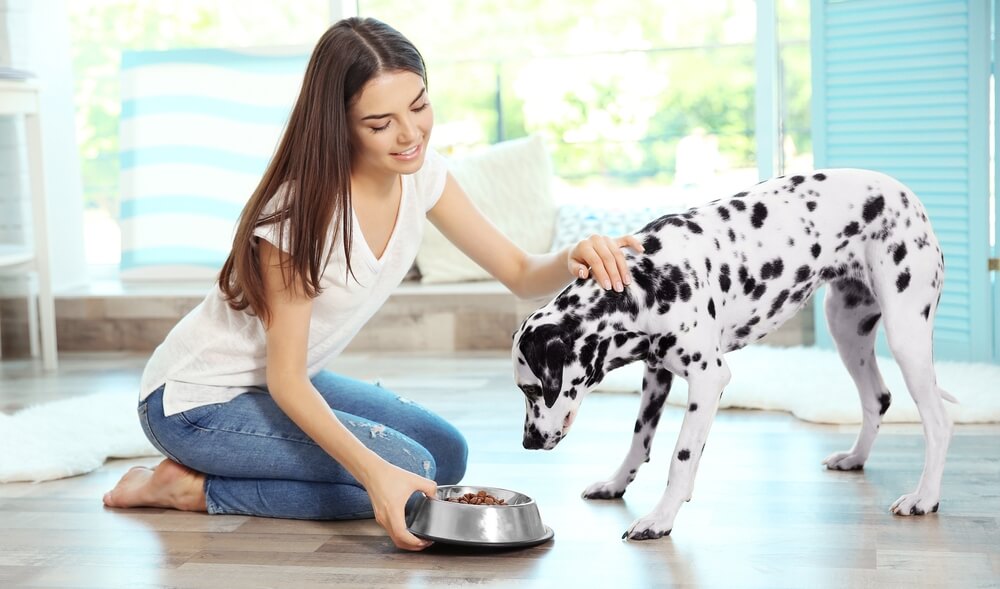DogFoodAdvisor is reader supported See how
Dog Food Advisor is 100% impartial and is never paid to promote any brand. But if you buy using links on this page, we may earn a referral fee.
There are many reasons why you might switch your dog to new food — including health reasons, weight management or allergies — and the transition is not always straightforward.
When switching your dog to a new food, it’s easy to cause digestive upset… and then unfairly blame the new diet.
This is especially common when you’re…
- Changing feeding type
- Moving from kibble to wet food
- Switching to fresh dog food
- When using diet rotation
Whether you’re looking to switch food because of health issues, your dog’s getting older or they’re just bored of their old food, it’s not always a straightforward transition. To avoid problems, it’s best to do your research beforehand.
So, many people ask is it bad to switch dog food? And how do you transition dog food without making your dog ill?
How to Switch Dog Food
In the video below… Dr. Gary Richter shares a simple feeding tip that can help lower your dog’s risk of getting sick when you switch to a new food
It’s best to switch your dog to a new food… gradually.
Start by mixing 20% “new” with 80% “old” food. Then, slowly increase that amount to a full 100%… over the next 8 to 9 days.
| Schedule | Old Food | New Food |
|---|---|---|
| Days 1 and 2 | 80% | 20% |
| Days 3 and 4 | 60% | 40% |
| Days 5 and 6 | 40% | 60% |
| Days 7 and 8 | 20% | 80% |
| Day 9 | 0% | 100% |
The key is not to move things on too quickly, as that could result in digestive problems for your pup, causing them potential upset and distress. If they begin to suffer stomach issues, revert back to the previous ratio, and either wait a few more days until their stomach has settled, or speak to your vet for advice.
The other important factor to note is to work out how much of the new food you should be feeding your dog. It may not be the same as the old food — knowing how much to feed your dog is not an exact science, and can take some trial and error. Use the serving suggestion on the packet, and tweak that over time depending on whether your dog gains or loses weight. Also read our guide on how often to feed your dog.
Our best dog foods also has more information on different types and brands.
How to Switch Puppy Food
Your puppy will have already transitioned from their mother’s milk to whichever food they’re currently on, and that in itself is not always straightforward, as their sometimes sensitive stomachs can easily react to the smallest of changes.
It’s worth spending time choosing the right food for your new puppy to begin with. However, if the food you choose does not work well for your pup, you’ll need to switch them to a new diet.
Again, the key word is ‘gradual’ — if you switch instantly there’s a risk you’ll upset your puppy’s stomach and cause more problems. Keep an eye on how their stomach’s reacting as you make the change — if it causes any gastrointestinal problems such as diarrhea or vomiting, return to the previous ratio of old/new food.
For more advice on types of puppy food, see our best puppy food guide.
Best Dog Food Brands
The pages below include some of The Advisor’s most recommended brands. Look for recipes rated 4 to 5 stars that match your dog’s ideal feeding type.
- Best Dog Foods by Category
- Best Puppy Foods
- Best Dry Puppy Food
- Best Wet Puppy Food
- Best Small Breed Puppy Food
- Best Large Breed Puppy Food
- Best Dry Dog Food
- Best Wet Dog Food
- Best Dog Food for Allergies
- Best Dog Food for Small Dogs
- Best Dog Food for Large Breeds
- Best Grain Free Dog Food
- Best Dog Food with Grain
- Best Fresh Food for Dogs
- Best Raw Dog Food
- Best Organic Dog Food
- Best Senior Dog Food
- Best High Protein Dog Food
- Best Freeze-Dried Dog Food
- Best Dog Food for Weight Loss
- Best Budget-Friendly Dog Food
- Best Dog Food for Sensitive Stomach
- Best Food for Specific Breeds
Final word
The Dog Food Advisor does not accept money, gifts, samples or other incentives in exchange for special consideration in preparing our reviews.
However, we do receive a referral fee from online retailers (like Chewy or Amazon) and from sellers of perishable pet food when readers click over to their websites from ours. This helps cover the cost of operation of our free blog. Thanks for your support.
For more information, please visit our Disclaimer and Disclosure page.
Article reviewed by
Laura Ward
Pet Nutritionist
Laura studied BSc (Hons) Animal Science with an accreditation in Nutrition at the University of Nottingham, before working for eight years in the pet food and nutrition industry.







